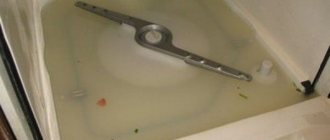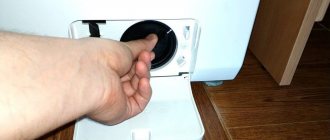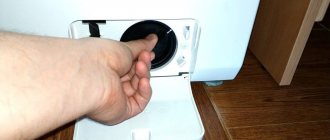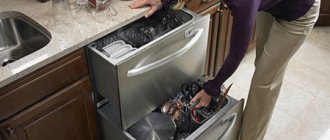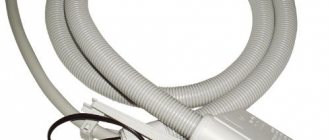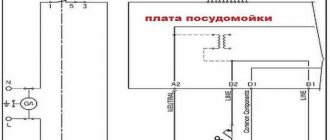4.9 / 5 ( 7 votes)
There is an opinion that to clean a dishwasher you just need to add detergent to the receiving tray and run the device “idle”. But in this way you are unlikely to remove the grease layer and limescale, clean the blades or remove solid debris from the drain filters.
To properly clean the unit, you need to give it a thorough cleaning. And here are the instructions on how to clean your dishwasher :
- What to do before cleaning the dishwasher?
- Cleaning seals, hoses, blades, filters, drain, baskets, inlet valve, pump.
- How to properly deal with complex stains: store-bought and home remedies.
- How to use a dishwasher: advice from professionals.
- Video tips for cleaning the dishwasher.
Eliminating scale, mold, grease and rust in the dishwasher
Removing scale, mold, grease and rust
If there are persistent contaminants inside the dishwasher, such as grease, scale, corrosion or mold, you cannot do without special cleaning compounds. You can buy professional products in the store and prepare them yourself.
Purchased funds
To descale your dishwasher, you can purchase one of the following cleaners:
- Finish Rinse . Japanese concentrated product that effectively removes scale. With this product you can easily clear a small blockage and say goodbye to unpleasant odors from the depths of the device. The manufacturer claims that the solution extends the service life of the unit.
- Finish Machine Cleaner . An effective two-layer product: blue liquid - against grease, white - against scale. The option when you need to clean your dishwasher quickly at home. The ease of use is captivating: unscrew the lid, turn the container upside down, and place it in the lower zone of the unit. To clean the car, it is enough to place the car wash at a temperature of 65°C.
- Filtero . The product is poured into the dispenser, depending on the degree of contamination, the machine is turned on for 1-1.5 hours, and the water is heated to the highest possible temperatures.
- Electrolux . If you need to clean your Electrolux dishwasher, purchase a branded product that will help remove small debris and grease layers. Electrolux powder, which is effective in removing scale, is also sold.
- "Antiscale" . Powder for degreasing surfaces, removing scale and limescale layers.
Do you need to know how to clean your washing machine with dishwashing tablets? Basically, all tablets, powders and gels work according to a similar scheme: drugs are loaded into an empty unit, work is started at a temperature of 45-90 ° C for a given time interval. To completely clean the equipment from “chemicals”, then turn on a short “idle” cycle.
Home Remedies
How to clean a dishwasher?
Recipes tested by housewives:
- Vinegar and soda against grease, rust, grease or mold. Here we will look at how to clean an Ariston dishwasher. Pour a glass of table vinegar into the dispenser, and sprinkle baking soda in an even thin layer on the bottom of the household appliance. Place the unit on the longest wash cycle. Once the machine has heated the water, press “Pause” and leave to soak for 30 minutes. Your dishwasher is clogged - how to clean the machine? If the car is very dirty, you can leave it overnight. Then remove from Pause and allow the device to complete the cycle.
- “2 in 1” soda tablets that remove grease, dirt and unpleasant odors. For a glass of baking soda - 15 drops of essential oil, 1-2 tbsp. spoons of hydrogen peroxide. Mix the ingredients into a homogeneous mass, reminiscent of wet fine sand. Roll balls from this mixture and place them on the bottom of the unit. To clean your dishwasher with a tablet, run the appliance on a long wash cycle.
- Lemon acid. On average, 150-200 g of product is required to clean one machine. Let's look at how to clean a dishwasher with citric acid. Turn on the washer at high temperatures, pause the device. Depending on the degree of contamination, leave to soak for 30 minutes or a couple of hours. Please note that citric acid must be used with great care - at high concentrations it is harmful to rubber parts.
Why is it important to clean the filter on time?
Before loading into the dishwasher, dishes and cutlery should be cleaned , ideally rinsed in warm water.
But, since completely ridding the dishes of all dirt would mean washing them, further use of the dishwasher loses all meaning.
Small particles of dirt will remain on the dishes before loading into the dishwasher in any case. But large ones must be removed in advance!
After starting the program, dirt from plates and pots is washed off with water and special detergents to the bottom of the washing chamber. This is where the drain cleaning filter , which is often called the “garbage filter”.
By retaining particles of food, grease, napkins and other debris, as well as detergents, the cleaning filter becomes dirty very often and quickly.
Given the importance of keeping the drain filter clean, some appliance manufacturers are already producing dishwashers with self-cleaning filters.
It is recommended to clean the regular filter yourself every time after completing the next washing cycle!
If you don’t have extra free time, clean the filter at least once every 2 weeks - 2 months (if you rarely use the unit).
Dirt and blockages in the filter provoke the following malfunctions of the dishwasher “assistant”:
- the water drains slowly, the wash cycle is extended,
- the water does not drain at all, it remains in the unit,
- water leaks through the door,
- the dishes are not washed, remain dirty, stained and stained,
- The machine makes louder noise, makes abnormal sounds,
- an unpleasant odor appears and harmful microorganisms multiply in the washing chamber.
Timely cleaning saves not only the filter itself, but also all other parts of the unit! After all, the motor, pump, heating element and other important components, in the event of improper functioning of the filter, have to work against wear and tear.
So, cleaning the garbage filter and unclogging it is a preventative measure that prevents most of the possible breakdowns of dishwashers! This is why it is so important to clean the filter promptly!
About dirty dishwashers
Like any other appliance, a dishwasher is subject to contamination, and manufacturers recommend cleaning it at least once a month. Depending on the frequency of use, this can be done less often.
The degree and speed of dishwasher contamination depends on several factors:
- The machine runs once a day or more often;
- The door remains closed after washing. In this case, there is a risk of mold growing inside the device;
- Hard water without softening salt for dishwasher;
- Very dirty dishes: with food residues, burnt parts and congealed fat;
- Washing at low water temperature;
- Washing plastic or wooden utensils not intended for use in the machine.
There are also several signs that indicate that your dishwasher needs cleaning:
- Unpleasant odor inside;
- Remaining dirt or white streaks on dishes after washing in the machine;
- Remaining food inside the chamber;
- Plaque on the filter;
- The water begins to drain slower than usual.
If at least one of these signs is present, then you should think about the fact that it’s time to wash the car. Despite its purpose, a dishwasher (even from well-known brands such as Bosch, Indesit) is not capable of cleaning itself; a person must do this.
Tips for using your dishwasher correctly
Tips for using a dishwasher correctly
When a dishwasher is clogged, not every user will understand how to clean it. To ensure that such a need arises as rarely as possible, take note of the advice of professionals:
- Before placing the dishes in the machine, be sure to wipe them with a napkin to remove large food residues.
- From time to time, check the compartments for detergent compositions and tablets - powder should not accumulate in pieces there.
- Place dishes in baskets correctly: on the lower ones - pots, baking sheets, frying pans, dishes and plates, on the upper ones - mugs and other “trifles” with the bottom up (so that water and detergent do not accumulate). Make sure that these items do not come into contact with each other.
- After each use of the unit, do not forget to wipe its surfaces, door and rubber seals with a soft cloth.
- Add special regenerating salts to dishwashing detergents. You can simply buy tablets with water softening ingredients.
- If you notice dirt, remove it immediately, rather than waiting for it to harden before the general wash.
- Do not forget to rinse the coarse filter after each cycle to remove accumulated debris.
- Once the machine has washed the dishes, leave them to dry with the door open. In more modern models, you can turn on auto drying for the same purposes.
How to properly clean the seal?
How to properly clean the seal?
The seal is a rubber element that you will find between the door and the main body of the unit. It is advisable to thoroughly clean it at least 2 times a year.
Simple rules on how to clean a dishwasher (Bosch, Electrolux, Ariston and other well-known brands):
- If the seal is slightly dirty, drip dishwashing liquid onto a washcloth and wipe the component. Then rinse with a cloth soaked in plain water.
- To remove grease from your dishwasher, you need a scrap toothbrush and a rubber cleaner. Do not use products containing alkalis or acids. They deprive the rubber of its elasticity - the seal will begin to leak water.
Cleaning dishwasher blades
How to clean the blade?
This part looks like a rocker arm. Both scale, grease, and food residues can accumulate on it. To clean the same Bosch dishwasher, you do the following:
- Remove the blades.
- Pour some warm water into a basin and add a delicate detergent.
- “Soak” the rocker arms for 5-10 minutes.
- Use a toothpick to clear any clogged dirt from the holes.
- Use a non-abrasive sponge to carefully remove soaked dirt and rinse the parts under water.
- Look at the axes where these elements are attached - fat and scale often accumulate on them, which need to be removed.
Removing dirt from baskets
The ingrained deposits of fatty deposits and scale are not so easy to wash off from the surface of the baskets. To make your task easier, use one of the commercially available PMM cleaning products (they will be discussed below).
Do the following:
- Place the baskets in a large container so that they fit entirely.
- Pour boiling water over them and add cleaning product.
- Leave to soak until the water cools down.
- Now use a soft brush and remove any remaining softened dirt.
Cleaning the basket from dirt with a toothbrush
